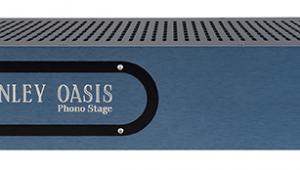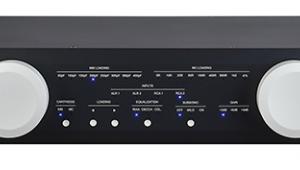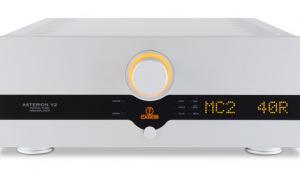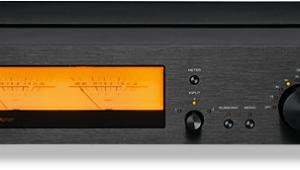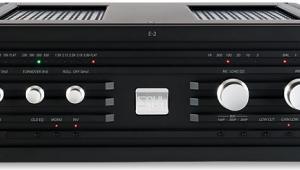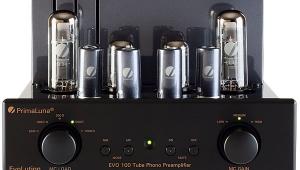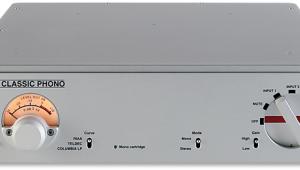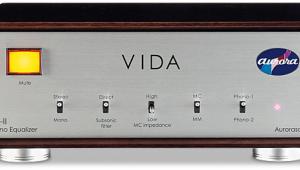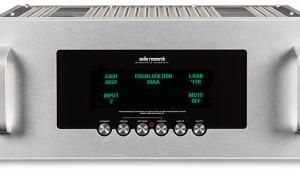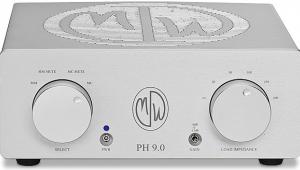Lehmannaudio Phonolith

 This latest two-box MM/MC phono stage from Germany also includes a line input and preamp alongside a fully discrete headphone amp. It's the brand's first 'analogue hub'
This latest two-box MM/MC phono stage from Germany also includes a line input and preamp alongside a fully discrete headphone amp. It's the brand's first 'analogue hub'
Is it my imagination, or are more hi-fi products steadily adopting greater functionality? Now, it's highly unlikely that Germany's resolutely 'analogue' Lehmannaudio brand will succumb to networking its phono stages any time soon, but the new £2599 Phonolith does wrap a trio of roles into one - an MM/MC phono stage, line level preamplifier and headphone amplifier. That said, it's not quite strictly rolled into 'one' as it's a two-box design, with the second unit being the standalone, dedicated power supply.
Of course, in typical Lehmannaudio fashion, these diminutive cases hide a good level of focused technology and functionality. The PWX II LZ power supply is a new variant of the company's PWX II PSU that has been used with other products and generates twin ±15V DC outputs through 4-pin XLR sockets at the rear. Internally, all components are high specification through-hole types, including four 4700µF Mundorf main smoothing capacitors. Both the PSU and main unit sit on Lehmannaudio's '3S device feet' for improved isolation and sound. The feet can be purchased separately in black or silver for use under other items, and start at £159 for a set of four '3S Point 1' models.
 linear PSU connects to the
Phonolith via an umbilical.
linear PSU connects to the
Phonolith via an umbilical.
Interior Design
The Phonolith itself is also very neatly constructed inside and, again, mostly based on through-hole passive componentry. The surface mount exceptions are the op-amps in the second stage of the phono amplification, plus the single op-amp in the volume control stage, and their associated bypass capacitors. For the first phono preamp stage, through-hole THAT Corporation op-amps are used that have seen service in many other Lehmannaudio products. These are supplemented by a selection of film capacitors in the RIAA EQ circuitry. The volume control, governed by a large front-panel rotary, is an ALPS Blue type.
 phono stage
combines a FET-input with passive RIAA [centre],
discrete headphone amp [left] and THAT line
preamp [right].
phono stage
combines a FET-input with passive RIAA [centre],
discrete headphone amp [left] and THAT line
preamp [right].
Down Under
The Phonolith has a variety of adjustments available on its underside [see pic, below] through the usual array of DIP switches, although these are usefully separated into three distinct banks. At the front of the unit are a pair that offer an additional +10 or +20dB gain to both line and phono options. In the centre are banks of three switches, two of which set the low frequency roll-off of the Phonolith's MM/MC subsonic filter. Options of 32Hz, 50Hz and 78Hz are available, but setting all switches to 'off' still leaves a roll-off at 7Hz, so the filter is never completely bypassed. The third switch adds in an optional extra gain of 10dB for the phono circuitry only.
 under the Phonolith,
DIP switches set MM/MC loading and gain
under the Phonolith,
DIP switches set MM/MC loading and gain
Tuning Choices
Towards the rear are final banks of six switches that alter gain and loading options. The first changes between MM and MC operation, with the MM setting giving a default load of 47kohm. When set to MC, various combinations of switches 2, 3 and 4 allow loads of 1kohm, 390ohm 280ohm, 100ohm or 74ohm to be set.
Switch 5 selects an internal location within the preamplifier that has no component fitted as standard. This allows a resistor of the user's choice to be added for cartridges with specific loading requirements. Fitting this resistor is a job that your dealer will be able to do for you, although the relevant locations actually have small receptacles to accept standard through-hole component legs, so no soldering is required. Finally, switch number 6 adds in a parallel 1nF capacitive load if this is desired.
Once these settings are made, the only front panel controls on the Phonolith are the volume and a small toggle switch that selects the phono or line input. A blue LED illuminates to show the unit is powered and a second blue LED beside the selector switch illuminates when the Line input is selected; between these is the 6.35mm headphone socket. All other inputs and outputs are through good, sturdy phono sockets - the layout is slightly unusual but this is dictated by the lack of rear-panel real estate.
 The PWX II
LZ PSU [bottom],
connects to the
Phonolith [top]
via an umbilical
and 4-pin XLR
plugs. A second
power outlet is
also provided. The
Phonolith includes
phono and line
inputs, with singleended
preamp outs
The PWX II
LZ PSU [bottom],
connects to the
Phonolith [top]
via an umbilical
and 4-pin XLR
plugs. A second
power outlet is
also provided. The
Phonolith includes
phono and line
inputs, with singleended
preamp outs
Phono Finesse
Kicking off with an Ortofon 2M Black installed in the SME 309 arm on my Michell Gyro SE turntable, and feeding my regular Yamaha M-5000 power amplifier , the Phonolith instantly brought to mind the character of the company's Decade Jubilee phono stage and its absolute mastery of the MM genre. I've owned the 2M Black for many years and it rarely sounds anything less than superb, but a few phono stages really do take it to another level, and the Phonolith is definitely one of them.
This phono amp's overall sonic balance is very much in line with my previous experience of Lehmannaudio's 'house sound' - no unnecessary treble boost, no over-exuberant thumping bass and no sense that the unit is attempting to impart any particular character onto the sound. The Phonolith is an effortless and subtle performer, its accuracy and sense of rightness gently working their way into your ears over a period of time. And it offers enough flexibility in gain and loading to get the best out of pretty much any cartridge likely to cross its path.
Setting The Stage
Given something relatively simple to work with, the Phonolith pulls everything out of the mix and paints it across the soundstage in a beautifully organised sweep. 'Fell Down Fast', from Kathryn Williams' album Little Black Numbers [Snowstorm STORM008LP], was a masterclass in stereophonic layout, with Williams firmly centre-stage, the cello just behind her, and guitars to the right. Nor was it all forensic detail and no heart - the cello strings were rich and vibrant, and each acoustic guitar note was defined with precision and clarity. Add in a sense of warmth and weight to the double bass and I was rewarded with a listening experience that was not only technically accomplished, but musically compelling.
Clearly the Phonolith is merely cruising with the higher output of moving-magnet pick-ups, so how does it fare with a more demanding MC? Swapping out the 2M Black for a Clearaudio MC Essence - while wielding a small screwdriver to reset the DIP switches governing gain and loading - revealed this phono stage's consistent sonic 'management' of both high- and low-output cartridge types. If you really want to listen to what your cartridge can deliver - unfettered rather than the buffed and tweaked version a phono stage thinks you might want to hear - then the Phonolith is your window onto the potential of vinyl.
One area which did improve slightly through Lehmannaudio's phono stage with the change to an MC pick-up was bass presentation. Through the MM settings, the low end was fulsome, but with a slight lack of texture at times. This is not a major problem, but meant that, occasionally, more insight into the minutiae of the instruments in action would have been welcome.
Digging In
With an MC cartridge in play, that insight appeared. Bass elements now had a touch more definition and detail. In MM mode it had still been hugely enjoyable, but the Phonolith was now really digging into the heart of the grooves. The gentle country of Eric Bibb's 'Needed Time', from his 1994 album Spirit And The Blues [Opus 3 LP19401], was delivered with impressive scale and insight. The Phonolith was in its element as strong, solid vocals, plus harmonica and slide guitar, played off the melodious double bass.
That said, there is always an underlying feeling of 'politeness' to this phono stage's low end. I've often found this to be a character of Lehmannaudio's hardware and I wonder if here it might be down to the unit's high-pass (subsonic) filter, which is never quite truly 'off'. All it means is that, while the Phonolith never sounds dull or leaden, with music that gets pacier and punchier the performance remains controlled, rather than baring its teeth.
Material like the extended 'Dance Mix' of the Pet Shop Boys' classic 'West End Girls' [12in single; Parlophone 12R6115] romped along joyously, with an excellent roundness to its rich bass synths, but I wanted it to let its hair down a bit more on a track like this!
Music Minded
The above is more of a passing observation than a criticism, as the phono stage's measured approach was never at the expense of the things I'd already grown to love about it. The soundstaging was still wide, deep and skilfully laid out, and the fine detail and nuance of its midband handling meant instruments, whether acoustic or electric, were believably rendered.
The Phonolith was also able to both effectively spotlight a prominent instrument within a simpler mix, and capture every essence of a rather busier recording. Even some extravagantly noisy stuff like the stomping rock of Biffy Clyro's 'Tiny Indoor Fireworks' [A Celebration Of Endings; Warner Records 0190295282097] was handled with assurance. Put simply, this is a phono stage that doesn't get in the way of the music.
Hi-Fi News Verdict
The Phonolith is another great product from Lehmannaudio. This phono preamp offers very flexible loading and gain options, and turns in a consistently fine performance with both MM and MC cartridges. With the bonus of a pleasingly transparent line stage and capable headphone amplifier, it's more versatile than perhaps it looks - the German brand really has crammed the proverbial quart into a pint pot.
Sound Quality: 84%

